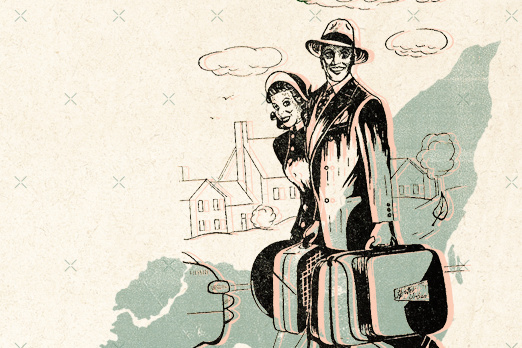Not so long ago, it was difficult, and sometimes even dangerous, to travel to North America if you had dark skin. In 1936, a New York postman, Victor Hugo Green, wanted to help his fellow citizens by establishing a list of boarding houses, hotels, restaurants and gas stations that welcomed African-Americans.
THE Green Book has become a real tool of freedom and dignity for black travelers, whether they are business people, artists or tourists.
Many discovered this story with the American film Green Bookreleased in 2018.
Quickly after the guide was released, Victor Hugo Green added good addresses in Canada, firstly in Montreal.
“Montreal was the Canadian metropolis,” recalls Greg Robinson, history professor at UQAM. It was a place that attracted black Americans, both for pleasure and for business. »
The city also gained prestigious status among the black community when the Montreal Royals baseball team hosted Jackie Robinson for the 1946 season.
“The fact that Jackie Robinson was a star in Montreal gave this city a reputation for welcome and tolerance which was not always real, authentic,” notes Mr. Robinson. Because here too, there was segregation. »
In the southern states of the United States, since the end of the 19th centurye century until 1965, laws institutionalized racial segregation. They were called the Jim Crow Laws, named after a caricatured black man. In the Northern states, segregation was more subtle, but still present.
“Montreal was no exception, it was part of North American culture,” says Dorothy Williams, a renowned historian specializing in the history of Black people in Canada. There was no Jim Crow Laws, but businesses could legally discriminate under a Supreme Court decision in the Fred Christie case. »
In 1936, the bartender of a tavern located in the basement of the Montreal Forum refused to serve Fred Christie, a black Montrealer. The Supreme Court then ruled that a business had the right to refuse to serve certain customers.

PHOTO PROVIDED BY DOROTHY WILLIAMS
Historian Dorothy Williams is a specialist in the history of black people in Montreal. She notably wrote significant books on this subject.
In the annals of justice, we find several cases of people who could not buy tickets to the cinema or, if they could, were seated in a separate section. The city was divided not only by language, but also by race.
Dorothy Williams, historian specializing in black history in Montreal
Black artists were not spared. In 1936, the great singer Marian Anderson was unable to stay at the Château Frontenac while she was giving a recital in the ballroom of this hotel. She must have moved in next door, at the Clarendon Hotel.
However, a black middle class was beginning to emerge in North America and many acquired a car to facilitate their travel and avoid discrimination on public transport. However, they faced hotel, restaurant and gas station managers who refused to serve them.
-

PHOTO PROVIDED BY THE NEW YORK PUBLIC LIBRARY
Cover of the 1940 edition of Negro Motorist Green Book
-

PHOTO PROVIDED BY THE NEW YORK PUBLIC LIBRARY
In the 1950s, the Negro Motorist Green Book becomes the Negro Travelers’ Green Book to reflect the different means of transport.
-

PHOTO PROVIDED BY THE NEW YORK PUBLIC LIBRARY
In the 1960s, we saw large hotels appear in the Green Book.
1/3
It was for them that Victor Hugo Green launched in 1936 The Negro Motorist Green Bookan annual guide which was enriched with new addresses with each new edition.
Victor Hugo Green relied in particular on the network of postmen in the United States to report good addresses to add in the following edition. He could also count on the network of sleeping car porters, mainly blacks, to obtain additional recommendations.
It’s really useful to have a guide who tells you who will accept you.
Greg Robinson, history professor at UQAM

PHOTO PROVIDED BY THE NEW YORK PUBLIC LIBRARY
In the Green Bookwe find advertisements for Esso stations managed by black people.
A large company, Esso, realized the importance of black customers and was very welcoming. As early as 1934, Esso hired an African-American, James A. Jackson, to explore this market. Esso service stations began offering the Green Book and, by the early 1940s, 312 of 830 Esso retailers in the United States were African-American.
The different editions of Green Book mark progress towards openness.
Greg Robinson, history professor at UQAM
In the 1960s, addresses appeared in Europe, Latin America and Africa.

PHOTO PROVIDED BY THE NEW YORK PUBLIC LIBRARY
In the 1956 edition, Victor Hugo Green underlines the 20e birthday of Green Book.
In 1964, the United States Congress passed the Civil Rights Actwhich prohibited discrimination on the basis of race, color or religion.
“As openness became universal, there was no longer a need for Green Book “, says Greg Robinson.
The last edition was published in 1966.
The great American museum institution Smithsonian has created a traveling exhibition on the Green Book, sponsored in particular by ExxonMobil (Esso). She can be seen in Los Angeles until March 10. She will subsequently travel to Atlanta and Cincinnati. The Smithsonian also offers a virtual exhibit.
